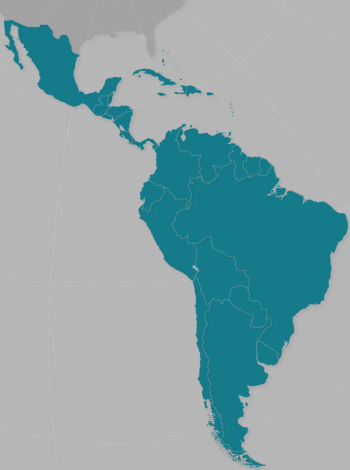The Demerara Rebellion of 1823 was an uprising involving more than ten thousand enslaved people in the Crown colony of Demerara-Essequibo (now part of Guyana) on the coast of South America. The rebellion took place on August 18, 1823, and lasted two days. No particular incident sparked the rebellion; the enslaved simply grew tired of their servitude and sought to resist in the most direct way they could.
Planning for the rebellion began on August 17, 1823, at Plantation Success, one of the largest estates in the area. Two leaders emerged during the planning period: Jack Gladstone, a cooper on Plantation Success, and his father, Quamina, a senior deacon at a church led by English Protestant missionary, John Smith. Gladstone and others planned the uprising, but Quamina objected to any bloodshed and suggested instead that the enslaved should go on strike. Quamina and other leaders visited John Smith, informing him of his son’s plans. Smith urged the enslaved to remain peaceful, exercise patience, and wait for new laws that would reduce their suffering. Quamina carried Smith’s message back to the plantations.
Quamina’s call to remain peaceful fell on deaf ears. The enslaved on Plantation Success rebelled the next evening, August 18, 1823, and attempted to seize all firearms on the plantation. They locked up the whites during the night, planning to release them when their demands were met. They did not see their rebellion as a challenge to slavery itself but demanded better treatment for enslaved people in Demerara-Essequibo.
Most of the enslaved remained loyal to their masters. An enslaved house servant, Joseph Packwood, told his owner, John Simpson, about the planned revolt before it began. Simpson, in turn, informed Governor John Murray, who rode out to confront the rebels with the militia. The enslaved demanded their rights, but Governor Murray ordered them to return to their plantations. When they refused, he declared martial law. Some returned to the plantations while others participated in the rebellion.
Only a handful of whites were killed during the Demerara Rebellion. The rebels locked up owners, managers, and overseers on thirty-seven plantations, who did not flee to Georgetown, the colonial capital, when the rebellion began. Large numbers of Christian slaves refused to rebel and helped suppress those who rose up.
Other enslaved people confronted their owners and the military forces sent against them. On Bachelor’s Adventure Plantation, approximately two thousand enslaved people confronted Lieutenant Colonel John Leahy and his militia. When the enslaved refused Leahy’s order to disperse, he commanded his troops to fire into the crowd. Approximately two hundred people were killed.
Although the rebellion ended on Tuesday, August 19, the punishment that came afterward was severe. Hundreds of rebels were hunted down and killed, including two hundred who were beheaded as a warning to other enslaved people. Fourteen rebels were hastily tried and sentenced to be hanged. Governor Murray commuted their sentences and had them deported elsewhere in Caribbean. Jack Gladstone was deported to St. Lucia. His father, Quamina, who had argued against the revolt, was tracked down by dogs and Indians and killed in September 1823.
Megathreads and spaces to hang out:
- ❤️ Come listen to music and Watch movies with your fellow Hexbears nerd, in Cy.tube
- 💖 Come talk in the New Weekly Queer thread
- 💛 Read and talk about a current topics in the News Megathread
- ⭐️ August Movie Nominations ⭐️
reminders:
- 💚 You nerds can join specific comms to see posts about all sorts of topics
- 💙 Hexbear’s algorithm prioritizes comments over upbears
- 💜 Sorting by new you nerd
- 🌈 If you ever want to make your own megathread, you can reserve a spot here nerd
- 🐶 Join the unofficial Hexbear-adjacent Mastodon instance toots.matapacos.dog
Links To Resources (Aid and Theory):
Aid:
Theory:


When I was like 14, I found a finepix something or other that looked like a fancy dslr but wasn’t. I had a ton of fun taking pictures till it broke.
Between then and now I haven’t owned a camera and I sorta grew a disdain for photographers. Not all photographers, but the gate-keepy gear heads who say things like “oh not everyone can just take good pictures” and use their camera on auto 100% of the time. I hated it because when I did it, I found it incredibly easy and decided that these people were full of themselves and put a bad taste in my mouth for photographers.
Years later, at my wedding, I fucking HATED my photographer. Asshole made rude comments, bragged about his Tesla(with an obnoxious telsa themed custom license plate) and ran the fucking camera on auto for all our pictures. The indoor ceremony pictures were missing so much fucking data because this asshole couldn’t bother to set a fucking ISO setting. He sent all the pictures as JPEGs so I couldn’t even try to do something with the raw photos. He made me hate photographers even more.
Today I was looking at an old archive of pics I took as a kid and felt tremendous warmth from the memories and decided I needed to try this again. Phone cameras are so tremendously lifeless. I bought an old canon G9 from Japan and I’m really excited to ride around town and take some pictures, especially when the leaves start changing color. Yeah I might still hate photographers but now I’ve accepted that I can still find many professional photographers smug and still enjoy taking pictures myself.
I once worked in a camera store/photo lab. I loathed a lot of our clientele for much the same reasons. I especially loathed the ones like the one who shot your wedding, who would buy expensive gear and not learn how to use it. I was often left dealing with their unfortunate clients, some of them in literal tears because their wedding photos were so awful. They came in hoping that we could somehow salvage usable photos from the garbage the “professionals” produced. But there was usually nothing I could do aside from recommend some genuinely good local professionals to do new studio and/or location sessions of the couple.
Yeah, there’s a lot of aggressive processing going on in phone cameras. Changing apps doesn’t help. It’s baked into the hardware. It’s a shame that they’ve destroyed the new compact camera market. There’s pretty much nothing newly-manufactured and pocketable that’s not a phone.
If you ever want to “upgrade” from that G9 (which is absolutely a gem, Canon packed a great lens into it) to something with interchangeable lenses, check out the micro-4/3rds cameras from Panasonic or Olympus from about 2015 onwards. My most-used camera is a Panasonic GX85 with a tiny little 12-32mm general-purpose lens that collapses almost flat when not in use. It’s almost identical in size to your G9. I have bigger/more expensive gear, but I rarely use them, because that GX85 is just so small and convenient to take anywhere.
I have a good friend who works in the smartphone business with imaging sensors and tuning so I get all the whys and hows from the source. For a while I was using the phone from his company and I’d send bug reports straight to him. I actually passed him some of my wedding photos to see if he could do anything with them and he got really upset for me that this dunce took my money. Best part is the ISO and all the other metadata was still in the files so I could prove he fucked up and took the photos at the wrong setting.
That’s why these assholes grind my gears so much, the way they’re so pretentious about something that is not that hard to get right, especially with a modern DSLR and a fancy lens and a big screen that shows you what the fucking picture looks like. At one point he handed me the camera to take some pictures of my wife, that’s when I noticed he had it on auto. He then rudely asked for the camera back, saying something like “aallriiight time to give it back to the pro”.
I appreciate the advice on the micro-4/3rds. I looked into those briefly and backed away because having to decide on both a body and lens was too much for me. If i end up enjoying this again I do want to experiment with lenses because I love the contraption nature of them. Thanks for the advice btw, I’m saving this comment for later.
This is one of the annoying things keeping me from switching to a feature phone.
Photography youtubers were a mistake
I honestly think this was an issue before photography youtube. I’ve met many bad photographers who do events and like to say “yeah that’s why people pay me to do this”. Years before influencer culture for this kinda thing was big.
It absolutely was a problem before youtube. Ken Rockwell : photography :: V**sh : US politics.
I’m actually reminded of an old coworker who was a trained photojournalist, and his experience left him with a bit of an attitude about it. Like he felt he couldnt get it wrong. Conversely, my own study in photography and I’m left with the impression i’m still not done figuring this craft out. I have thousands and thousands of photos now, and not many of them will see the light of day.
Your photos are probably just fine, they’re uniquely you and your perspective of the world, let em rip comrade.
That’s part of why I don’t get being “good” at photography. There’s the basic device control, which has been made incredibly automated by technology. Then there’s composition, that’s the artistic angle. There’s formal techniques but then there’s also just trying to capture what you see. That’s the art in it.
Photography is another profession (along with graphic design, printing, and most other graphic arts) that has been ruined by corporatization. You have to be a pretty big sicko to withstand the current “creative” business culture, so only sickos make it in the industry. Self fulfilling proficiency. These fields are skilled trades! Give us trade schools and unions PLEASE :(
I have a friend who does graphic design by trade and photography for a hobby and the stuff they work on sounds so degrading.
The problem isn’t so much the work, it’s more the culture surrounding the work. most designers don’t have a problem doing boring shit, boring shit is fine, it gets the bills paid, I don’t have to think, whatever. There’s this whole hyper-competitive attitude around the whole industry, and everyone is a critic. You have to establish an whole “designer persona”. Are you in on the trends? What’s in and what’s out? Are you falling behind? Are you a true creative, or just another dolt who thought they could make it? Oh honey you’re just another print shop designer, this is corporate work 💅. The truth that none of these people CANT acknowledge (because it would destroy the persona they’ve created around themselves) is that 99% of a designers applicable profitable worth anything skills are actually composition, making a client happy, and software. Clown show fr